Kathleen Flinn's Blog, page 31
July 15, 2011
Summer Berry Tart
 Someone asked me recently why I didn't study pâtisserie at Le Cordon Bleu. The honest reason? I'm not keen on most sweets and I don't like chocolate. (Yes, you read that correctly.) If there's a choice of dessert or a cheese plate, I always go for the fromage. When I started to review restaurants back in the 1990s, I routinely left a report on desserts out of my reviews. I was working then with Tom Sietsema, now the restaurant reviewer at The Washington Post. Tom said, "Kat, you have to write about dessert. That's the reason why some people go out to dinner." For years I trudged through all the classic dessert clichés, the endless variations on cheesecake, carrot cake and creme brulée. I died a thousand deaths by chocolate.
Someone asked me recently why I didn't study pâtisserie at Le Cordon Bleu. The honest reason? I'm not keen on most sweets and I don't like chocolate. (Yes, you read that correctly.) If there's a choice of dessert or a cheese plate, I always go for the fromage. When I started to review restaurants back in the 1990s, I routinely left a report on desserts out of my reviews. I was working then with Tom Sietsema, now the restaurant reviewer at The Washington Post. Tom said, "Kat, you have to write about dessert. That's the reason why some people go out to dinner." For years I trudged through all the classic dessert clichés, the endless variations on cheesecake, carrot cake and creme brulée. I died a thousand deaths by chocolate.
Last month, I was a guest chef at Rancho La Puerta in Mexico, a health-focused spa straddling the U.S. border at Tecate an hour from San Diego. As part of the hands-on classes I taught to guests there, I had to develop dessert. The recipe had to fit certain parameters: less than 80 calories a serving, no white sugar, preferably no white flour. I decided to use it an excuse to finally find a dessert that I like well enough to make it routinely. I've been making a whole wheat tart crust for ages based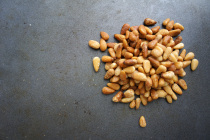 on a recipe from Clotilde Dusoulier's blog Chocolate and Zucchini. I know they grow beautiful berries at the ranch, so after some trials, I developed this recipe as a way to balance out the fresh, sweet flavors of the fruit in a light custard sweetened by honey aided by a savory bite of pine nuts, a twist on a recipe in Patricia Wells' excellent cookbook, At Home in Provence. My mother says this tart is now her favorite dessert, and I think it's mine, too.
on a recipe from Clotilde Dusoulier's blog Chocolate and Zucchini. I know they grow beautiful berries at the ranch, so after some trials, I developed this recipe as a way to balance out the fresh, sweet flavors of the fruit in a light custard sweetened by honey aided by a savory bite of pine nuts, a twist on a recipe in Patricia Wells' excellent cookbook, At Home in Provence. My mother says this tart is now her favorite dessert, and I think it's mine, too.
Mixed fruit tart with pine nuts, thyme and honey
with a whole wheat olive oil crust
This works best in a tart pan with a removable bottom, but if you don't have one, a standard pie plate will be just fine. The dough makes enough to line an 11- to 12-inch tart or pie pan. Any mix of fresh fruit will work; it's excellent when made with bananas. Makes about eight servings.
Crust
2 cups (250 grams) light whole wheat flour
or a 50/50 mix of all-purpose and whole wheat
- 1 teaspoon fine sea salt
- 1 teaspoon dried thyme
- 60 ml (1/4 cup) olive oil (or the oil of your choosing, provided it withstands cooking)
- 135 ml (1/2 cup + 1 tablespoon) cold water
Filling
1/2 cup (120 ml) heavy cream
2 large eggs, lightly beaten
1/2 teaspoon vanilla extract
2 tablespoons raw full-flavored honey
1/4 cup pine nuts, lightly toasted, then crushed
Enough fresh summer fruit such as strawberries, peaches, raspberries and blueberries and plums to fill your pie plate or tart tin (typically about 3 cups when prepped)
About a tablespoon of fresh thyme leaves
Preheat the oven to 400° Fahrenheit (200° Celsius).
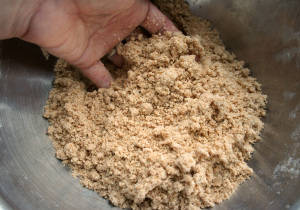
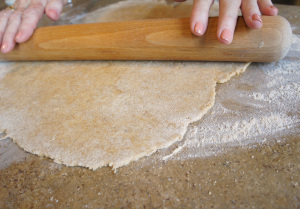 Prepare the crust: Grease the pan lightly or coat with cooking spray. Combine the flour, salt, and herbs in a medium mixing bowl. Add the oil and mix it in with your fingers until the olive is distributed evenly. It should have the consistency of coarse cornmeal. Add the water, mix until absorbed, and then knead lightly by hand until the dough comes together into a ball.
Prepare the crust: Grease the pan lightly or coat with cooking spray. Combine the flour, salt, and herbs in a medium mixing bowl. Add the oil and mix it in with your fingers until the olive is distributed evenly. It should have the consistency of coarse cornmeal. Add the water, mix until absorbed, and then knead lightly by hand until the dough comes together into a ball.
Turn the dough out on a lightly floured work surface. Sprinkle a little flour on the dough and a rolling pin, and into a circle large enough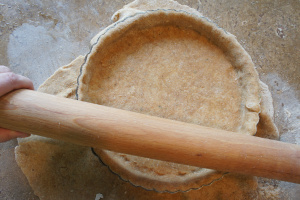 to fit your tart pan. Do this by turning the dough slightly every time you roll it, adding a little more flour underneath and on top when it seems on the verge of becoming sticky. Avoid overworking the dough.
to fit your tart pan. Do this by turning the dough slightly every time you roll it, adding a little more flour underneath and on top when it seems on the verge of becoming sticky. Avoid overworking the dough.
Transfer the dough carefully to line the bottom of the prepared pan and trim the excess. If you're using a traditional French tart pan, you can just run a rolling pin across the top to trim it against the sharp edges. Let it rest in the fridge for 25 minutes while you prepare the fruit and the filling.
 [image error]Prepare the fruit and filling: Wash, pit, trim or slice the fruit needed, and cut into roughly similar sized pieces. Combine the cream, eggs and vanilla extracts in a bowl. Add the honey and whisk to blend. Toast the pine nuts lightly and stir into the cream.
[image error]Prepare the fruit and filling: Wash, pit, trim or slice the fruit needed, and cut into roughly similar sized pieces. Combine the cream, eggs and vanilla extracts in a bowl. Add the honey and whisk to blend. Toast the pine nuts lightly and stir into the cream.
Get the crust from the fridge. You'll probably notice small white dots in it. That's good. It means the olive oil and the dough are chilled through. Prick the crust with a fork. Neatly overlap large chunks of fruit in circles around the edges, working toward the center.
Pour the cream filling carefully around the fruit. Sprinkle the herbs on top. Place in the center of the oven and bake until the filling is firm and the pastry is brown, about 40 minutes. The fruit may shrivel slightly. Remove to a rack to cool.
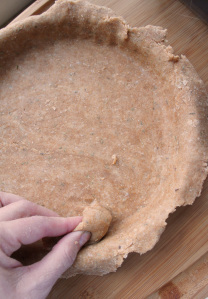 French Tip: Press the crust into the pan with a small remnant pie of dough. It provides more uniform pressure and you'll avoid piercing it with your fingers by accident.
French Tip: Press the crust into the pan with a small remnant pie of dough. It provides more uniform pressure and you'll avoid piercing it with your fingers by accident.
Other fruit tart recipes I like:
-Bake or Break: Fresh berry Tart
-The Gourmet Project: Tart with marscapone
-Smitten Kitchen: Strawberry lemon tart
-Cheeky Kitchen: Super quick berry tart
-Gluten Free Goddess: Gluten-free berry tart
-You're Gonna Bake it After All: Berry tart with sweet cookie crust
Amazon: My favorite French gadgets








July 13, 2011
A Few Good Food Links
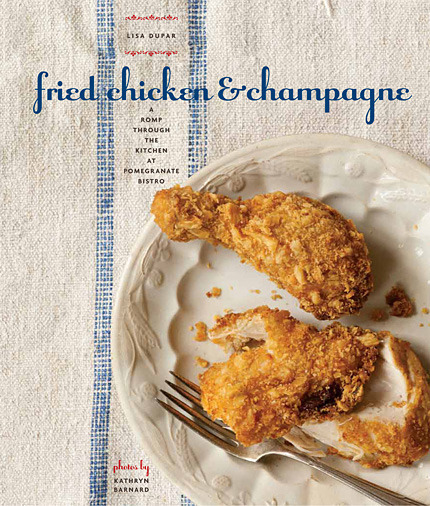 This week, yet more evidence to confirm the addictive nature of some foods. I'm not quite sure that everyone needed a study to confirm, but GrubStreet's excellent headline said it all: "You're physically unable to resist fried chicken." The gist of the studies findings? Fried chicken yields the same responses as drugs. Depressingly, a growing body of research supports the notion that what we traditionally think of guilty pleasure-style food such as those laden with salt, sugar and fat such as fried foods, potato chips and (sadly) bacon generate the same reactions in the brain as heroin or smoking, and thus, can be just as addictive. (The photo is the cover of Fried Chicken and Champagne by Seattle caterer Lisa Dupar, which just won the Julia Child First Book Award at IACP. You can find her fried chicken recipe here. I've made it, and will confirm it's addictive. Damn, I want some fried chicken right now.)
This week, yet more evidence to confirm the addictive nature of some foods. I'm not quite sure that everyone needed a study to confirm, but GrubStreet's excellent headline said it all: "You're physically unable to resist fried chicken." The gist of the studies findings? Fried chicken yields the same responses as drugs. Depressingly, a growing body of research supports the notion that what we traditionally think of guilty pleasure-style food such as those laden with salt, sugar and fat such as fried foods, potato chips and (sadly) bacon generate the same reactions in the brain as heroin or smoking, and thus, can be just as addictive. (The photo is the cover of Fried Chicken and Champagne by Seattle caterer Lisa Dupar, which just won the Julia Child First Book Award at IACP. You can find her fried chicken recipe here. I've made it, and will confirm it's addictive. Damn, I want some fried chicken right now.)
More good links:
There's something about SaltySeattle. Funny, spunky and well dressed, it's all good, quirky fun over at her place, from classics such as 21st Century Dinner Party Etiquette to her frolicking in a bikini made out of Peeps. This week's headline: "Food CAN Induce Orgasm." One of the accompanying photos echoes visions of, oh, the, uh… Hmmm. How to explain. This is a G-rated blog. Imagine glistening tartare-quality raw beef deftly folded to remind a viewer of the flower of feminine physicality. We move swiftly on.
Fine Cooking's interactive Recipe Makers offer an educational way to start thinking about how to cook via formula and ratio, rather than recipe. Plus, it feels like an online kids game. My favorites are the Thai curry and the ice cream, the latter by David Lebovitz. (You'll need Adobe Flash to make the magic happen.)
Not really a food link, but we're trying to develop a logo for a new site based on the upcoming book. My friend Taylor at The Happy Girl Experiment turned me onto this site, Mycroburst, where you can name your price and designers around the work vie to win "your contest." So far, we are at nearly 500 entries. Take a look, got any favorites?








July 8, 2011
Salade Niçoise
I first encountered Salade Niçoise in a romance novel, when a beautiful protagonist perched at a table under a striped umbrella on an immaculate beach in Cannes waiting for a murky character. The server brought her a bracingly cold glass of chablis and a crisp Salade Niçoise. At this point, the author abandoned the entire plot to wax poetically about the pungent olives, crisp green beans and plump tomatoes for at least two pages. I don't know what happened to the character. I put down the book and picked up The French Chef by Julia Child. Age 14, I made it sans anchovies and with green olives a couple of days later. At age 34, while living in London, I fled to Cannes for the weekend alone for the sole purpose of recreating that scene. As I sat under a striped umbrella, alone with a glass of wine waiting for my salad, I wondered whatever happened in that book?
 In the heat of summer, or what passes for it in the Northwest, Salade Niçoise is one of my go-to dishes. Tomatoes, green beans and greens are fresh and plentiful and the rest of the dish comes from the fridge or pantry, namely eggs, olives, capers, anchovies and canned tuna.
In the heat of summer, or what passes for it in the Northwest, Salade Niçoise is one of my go-to dishes. Tomatoes, green beans and greens are fresh and plentiful and the rest of the dish comes from the fridge or pantry, namely eggs, olives, capers, anchovies and canned tuna.
However, the latter is a point of contention. There's a raging debate about the use of fresh versus canned fish. Even Dorie Greenspan writes in Around My French Table that a French friend implored that she "not go all modern and use fresh tuna." The second line of my notes on the dish from Le Cordon Bleu read: "Always canned tuna, packed in oil." (I think it was The Gray Chef from Sharper, a culinary purist.)
Auguste Escoffier, the man who codified French cuisine described the dish as "equal quantities string beans, potato dice and quartered tomatoes. Decorate with capers, pitted olives and anchovy fillets. Season with oil and vinegar." Note the glaring lack of tuna, canned or otherwise, in the description. Another point of contention: Should the ingredients be cordoned off into ghettos , the green beans to one side, the potatoes to another? Escoffier generously allowed that the arrangement of vegetables were "subject to no rules, merely a matter of taste." I mix it up.
, the green beans to one side, the potatoes to another? Escoffier generously allowed that the arrangement of vegetables were "subject to no rules, merely a matter of taste." I mix it up.
When tuna is the star, don't reach for Starkist. Splurge on a Mediterranean variety, or better yet, a sustainably caught albacore such as the brand I use here in Seattle from the fishing boat St. Jude. After years of making and eating Salade Niçoise in several countries, I've come down to this variation on Julia's classic. Nothing wrecks this salad faster than bland, cold potatoes, so I prefer the classic approach to flavor them in their own right first as a potato salad (photo right). Escoffier didn't mention lettuce, either. I'm partial to a simple butter lettuce or a fresh arugula. The latter has some bite which adds depth to the salad. I'm sure that's going to get me into trouble with the purists.
Salade Niçoise
Serves four as a main course.
Thyme-lemon vinaigrette
1/2 cup olive oil
2 tablespoon fresh lemon juice
1 teaspoon mustard
1 teaspoon dried thyme
Coarse salt, ground black pepper
Potato Salad
1 lb. Yukon gold or new potatoes, quartered
2 tablespoons dry white wine
2 tablespoons chicken stock
2 tablespoons chopped parsley
1 tablespoon minced shallot
salad components
1 cup, about 6 ounces, cooked green beans
1 cup halved cherry tomatoes
4 ounces butter lettuce, arugula or other simple greens
1/2 cup pitted black olives, such as kalamata or Niçoise
3 or 4 hard-boiled eggs, roughly chopped or quartered
12 anchovy fillets
7 oz. can tuna, packed in olive oil
Prepare the vinaigrette:
In a small bowl or jar, mix the lemon juice, olive oil, thyme, two pinches of salt, coarse ground pepper and shake or whisk together until emulsified. Set aside until needed.
Prepare the potato salad:
Steam or boil the potatoes just until tender. Cut into bite-sized pieces while still warm and toss gently with the white wine and stock. After a few minutes, toss again.Toss half the vinaigrette with the potatoes, chopped parsley and shallots.
Finish the salad:
Arrange the cooked green beans, tomatoes, lettuce, hard-boiled eggs and olives in a bowl. Toss with the vinaigrette. Arrange the elements onto four plates, top each with the anchovies and tuna.
 French Tip: To keep the green beans crisp and retain bright color, boil briefly just until tender, then plunge into an ice bath.
French Tip: To keep the green beans crisp and retain bright color, boil briefly just until tender, then plunge into an ice bath.
Other Salad Nicoise recipes I like:
Simply Recipes (classic version)
Last Night's Dinner (from leftovers)
Just Bento (with an Asian twist)
Feeding Maybelle (vegan)












